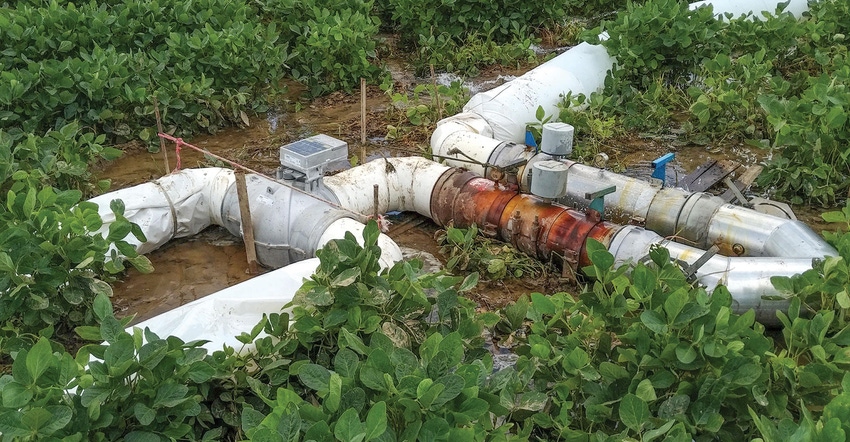
A U.S. Geological Survey report back in the 1970s caught Arkansas farmer Mike Wood’s attention.
“That’s when I got interested in water conservation,” Wood said in a recent University of Arkansas Water Conservation Virtual Field Trip.
From his Cherry Valley farm, Wood explained that the USGS report indicated that the region’s aquifer would decline by 1 foot per year. At the time, the aquifer was measured at 50 to 60 feet. “Now, it’s 100 to 110 feet, so the prediction was true,” Wood said. “That sparked my interest in conservation.”
He had been farming on his own for just a few years when he heard that ominous report. He started farming in 1972, moved back to the home farm in 1977 and took over the operation when his father died in 1979.
Without his father’s guidance, he said he leaned on other sources for information.
“I relied heavily on Extension for information. I offered the farm for demonstrations to learn all I could about farming. And I went to all the meetings I could attend.”
Conservation has been a crucial part of his quest for information. His concern over the declining aquifer convinced him to look at other options. “In the early 1990s I installed a relay pump from the L’Anguille River and tied into underground pipe, so I could use surface water and not depend on groundwater.”
He also began working with Phil Tacker, a University of Arkansas Extension engineer, on water quality. “He monitored water quality from the wells and out of the field. At the end of the year, we collected data and found that the water runoff was of higher quality than the water out of the well. Rice filtered out the impurities.”
He also planted grass filter strips along the river in areas that frequently flooded out into his fields. “I planted trees in places I couldn’t irrigate.”
Recycling plays an important role in irrigation management. “I started a tailwater recovery project, adding a re-lift at the bottom of the field and pumping water back to the top.”
He says that project conserves water and reduces runoff into the river.
Discovery Farm
He’s always willing to do more. “In 2010, Mike Daniels (co-director of the University of Arkansas Discovery Farm Program) approached me about participating in the Discovery Farm Program.”
That program, according to the University of Arkansas website, “is privately owned businesses on which water quality research is being conducted. And is designed to operate for five to seven years during which time water quality analysis and data reveal the effectiveness of conservation practices employed at each site.”
Wood said research through the Discovery Farm initiatives help quantify nitrate runoff, which some claim contributes to nitrification in the Gulf of Mexico.
“I’ve been participating since 2010,” Wood says. “It has been enlightening.”
He’s taken advantage of other opportunities to improve water management. “In 2012, the L’Anguille River watershed was determined to be an essential water source.” That opened opportunities to use cost-share funds to improve water conservation.
The Natural Resource Conservation Service (NRCS) offered to pay 75% of the cost of a 30-acre reservoir. “We built the reservoir and tied it into underground pipes with three wells. That was a great investment.”
He says after the reservoir was tied into his system, he abandoned a weak well that had run out of water and did not need to replace it.
Surge valves
His latest moisture management upgrade includes surge valves and moisture sensors. He compares traditional poly-pipe furrow irrigation to surge irrigation in soybeans. “With the surge, we alternate between two lines, one on for 2 to 2.5 hours and then switch to the other and go back and forth for about 24 hours, or when we reach the bottom of the field. That ranges from 24 to 30 hours.”
He installed soil moisture sensors to determine moisture levels in the soil profile. Sensors are set at 12-, 18-, 24- and 30-inch depths.
He says moisture on the traditional irrigation run reached only 12 inches. “With the surge valve, we drive moisture down to 24 inches. We get a lot better infiltration and can eliminate at least one irrigation, depending on the year. In a dry year, we may save a second irrigation. This is a tremendous piece of technology.”
University of Arkansas irrigation educator Mike Hamilton says surge valves may save as much as 50 percent in irrigation costs a year.
Wood says farmers have resources available for conservation projects. “I am thankful to NRCS for their programs,” he says. “The Environmental Quality Improvement Program (EQIP) helped with the reservoir, underground pipes and other projects. That’s a great help.”
He says through the Discovery Farm Program he has improved farm conservation with grass filter strips, tailwater recovery, reservoir construction and fine-tuning irrigation.
Lee Riley, University of Arkansas, Division of Agriculture Cooperative Extension Service, moderated the virtual field trip, which is part of the Arkansas Soil & Water Conservation Virtual Field Trip Series. Riley said support for the series comes from USDA/NRCS in its charge to integrate the efforts of the Arkansas Discovery Farms program and the Arkansas Soil Health Alliance.
Farmers can do little about recharging aquifers, but with on-farm conservation practices like the ones demonstrated through Discovery Farms and the ones Wood has installed, they can make every drop count and keep water, soil, and nutrients in the fields and out of the river.
About the Author(s)
You May Also Like






